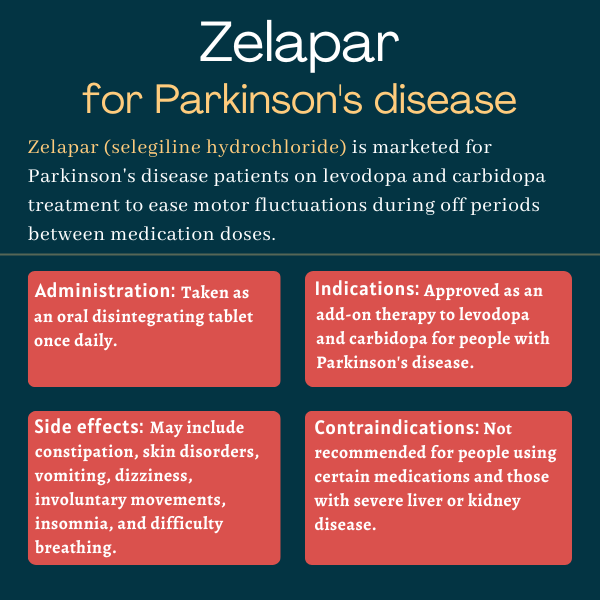Zelapar (selegiline hydrochloride) for Parkinson’s disease
What is Zelapar for Parkinson’s disease?
Zelapar (selegiline hydrochloride) is an oral add-on therapy used to help control off episodes and ease motor fluctuations in Parkinson’s disease patients who already are on levodopa and carbidopa treatment.
It was developed by Valeant Pharmaceuticals, which in 2018 changed its name to Bausch Health.
Therapy snapshot
| Brand name: | Zelapar |
| Chemical name: | Selegiline hydrochloride |
| Usage: | Used to manage motor fluctuations in Parkinson’s disease patients using levodopa and carbidopa therapy |
| Administration: | Orally disintegrating tablets |
How does Zelapar work?
The hallmark motor symptoms of Parkinson’s disease, are caused by the loss of nerve cells, called dopaminergic neurons, that produce the signaling molecule dopamine. Patients normally are treated with levodopa and carbidopa to supply the brain with dopamine precursors. However, the medication’s effects may wear off between doses, leading to off episodes or motor fluctuations that can worsen over time. Furthermore, higher levodopa doses can result in involuntary movements known as dyskinesia.
Zelapar is a drug that inhibits an enzyme called monoamine oxidase B, or MAO-B, that normally breaks down dopamine. By blocking this enzyme, Zelapar helps maintain dopamine levels and alleviate motor fluctuations in Parkinson’s patients using levodopa and carbidopa.
The mechanisms of how Zelapar provides benefits in the treatment of Parkinson’s disease are not fully understood, however. There is evidence that Zelapar might work in other ways to boost dopamine-related activity, potentially by interfering with dopamine re-uptake at the junction between nerve cells.
Who can take Zelapar?
Zelapar was approved by the U.S. Food and Drug Administration (FDA) in June 2006 as an add-on therapy for Parkinson’s patients using levodopa and carbidopa. It treats patients who experience a decline in the quality of their response to their prescribed treatment.
Who should not take Zelapar?
Zelapar should not be used by people taking any of the following medications:
- other monoamine oxidase (MAO) inhibitors or medications with MAO-inhibiting properties (e.g. linezolid)
- opioid medications (tramadol, meperidine, or methadone)
- cyclobenzaprine (a muscle relaxant)
- St. John’s wort (a plant used for conditions such as depression, attention-deficit hyperactivity disorder or obsessive-compulsive disorder)
- dextromethorphan (a cough suppressant).
Zelapar also should not be used by people with severe liver problems or severe kidney impairment, including those with end-stage renal disease.
Because it contains the amino acid phenylalanine, Zelapar can be harmful to patients with phenylketonuria, a rare disorder that causes the protein building block phenylalanine to build up in the body.
Patients with a major psychotic disorder should not be treated with Zelapar due to the potential for worsening of their psychosis.
How is Zelapar administered in Parkinson’s?
Zelapar tablets are light yellow with a stylized “V” imprint, and are available for oral administration at a strength of 1.25 mg. The tablets are dissolved in the mouth.
Treatment with Zelapar should be started at a 1.25 mg daily dose, given for at least six weeks. If the patient is able to tolerate the medicine but if the desired benefit has not been achieved after six weeks, the dose may be increased to 2.5 mg once a day.
Zelapar should be taken in the morning before breakfast; the tablet should be placed on the tongue and allowed to dissolve. Patients should avoid eating, drinking, or mouth-rinsing for five minutes before and after taking the medicine to allow it to be absorbed. Zelapar disintegrates within seconds after being placed on the tongue.
For patients with mild to moderate liver disease, the daily Zelapar dose should be lowered from 2.5 to 1.25 mg per day, based on clinical responses.
Zelapar has only been shown to be effective when used in combination with levodopa therapy, and should not be discontinued abruptly as this may cause severe side effects.

Zelapar in clinical trials
Zelapar’s approval was largely based on data from a clinical study that enrolled 140 participants who received either Zelapar or a placebo. Patients were enrolled if they had an average of at least three hours of off time per day.
Those on Zelapar received an initial daily dose of 1.25 mg for six weeks, followed by 2.5 mg for the remaining six weeks. All patients also were using levodopa, and could use other medications, such as dopamine agonists, anticholinergics, amantadine, or a mix of these.
The main measure of effectiveness was a decrease in the amount of time spent in the off state during the day, from the beginning to the end of the trial.
Significant reductions in daily off time occurred at four to six weeks with the 1.25 mg dose and at 10 to 12 weeks with the 2.5 mg dose. Patients on Zelapar experienced a 13% decrease in their daily off time — a reduction of 2.2 hours per day — by the end of the study, or week 12. That compared with a 5% decrease for those on the placebo, who saw a reduction of 0.6 hours in off time per day.
Common side effects of Zelapar
The most commonly observed side effects of Zelapar include:
- constipation
- skin disorders
- vomiting
- dizziness
- dyskinesia, or involuntary movements
- insomnia
- difficulty breathing, called dyspnea
- muscle pain, known as myalgia
- rash.
Blood pressure
Zelapar can cause high blood pressure, known as hypertension, or worsen high blood pressure in some cases. Patients should be closely monitored while using Zelapar and should not exceed the recommended daily doses.
Taking Zelapar with certain foods that have tyramine, an amino acid that regulates blood pressure and which is broken down by MAO, may cause hypertension. Examples of tyramine-rich foods include smoked, cured, or processed meats, alcoholic beverages, aged cheeses, pickled or fermented foods, soybeans, and yeast extracts.
Patients taking certain other medications, such as ephedrine, used to manage and treat low blood pressure, also should be monitored for hypertension.
Zelapar also can lead to low blood pressure, especially a type called orthostatic hypotension, in which a person’s blood pressure drops when standing up from a sitting or lying down position.
Serotonin syndrome
For patients using other MAO inhibitors or certain antidepressants, Zelapar can cause a serious condition called serotonin syndrome, wherein levels of the serotonin brain signaling chemical become too high.
Symptoms may include mental changes such as confusion, hallucinations, and agitation, and physical effects like muscle rigidity, twitching, and tremors. There also may be autonomic effects, meaning those involving unconscious bodily functions, such as sweating, digestion, and blood pressure. Patients may experience fainting or fever in some cases.
As such, Zelapar should not be taken by patients using any of these medications.
Sleepiness
Patients on Zelapar or similar medications that boost dopamine levels have experienced falling asleep during everyday activities, including driving, which can lead to accidents. While some individuals felt drowsy before, others did not sense the sleepiness and thought they were alert just before these incidents. Some cases occurred even up to a year after starting treatment.
If patients experience these symptoms, Zelapar treatment should be discontinued. If a decision is made to continue Zelapar, patients should be advised not to drive or engage in other potentially dangerous activities.
Dyskinesia
Some patients taking Zelapar might notice new or increased dyskinesia. In such cases, lowering the levodopa dosage may lessen this side effect.
Hallucinations or psychosis
Zelapar may cause or exacerbate symptoms of psychosis, including hallucinations – experiencing things that are not there – and delusions, or beliefs not based in reality.
The therapy typically is not recommended for patients with an existing major psychotic disorder.
Impulse control issues
Increased dopamine levels resulting from Zelapar or similar treatments can contribute to impulse control issues, such as difficulties in managing urges related to gambling, sexual activity, spending money, or overeating.
Because these behaviors may not always be obvious, it’s crucial for doctors to inquire about them directly with patients or their caregivers. If such symptoms appear, reducing the dosage or discontinuing treatment might be necessary.
Withdrawal-emergent fever and confusion
Suddenly stopping or reducing certain antiparkinsonian medications may cause a withdrawal symptom characterized by increased body temperature, muscle rigidity, and changes in consciousness and automatic bodily functions. It’s generally recommended that patients who plan to stop taking Zelapar reduce their dosage gradually.
Irritation of the mouth
Zelapar can lead to mouth irritation, including pain when swallowing, mouth discomfort, and redness, swelling, or ulcers in specific spots on the inner cheek.
Pregnancy and breastfeeding
There is no adequate information about using Zelapar in pregnant women, but animal studies suggest it could harm the fetus if taken during pregnancy. Pregnant patients or those planning to become pregnant while using Zelapar should talk to their healthcare provider.
It also is not known if Zelapar can be found in human breast milk. It’s important to weigh the advantages of breastfeeding against the mother’s need for Zelapar and the possible risk to the nursing baby.
Parkinson’s News Today is strictly a news and information website about the disease. It does not provide medical advice, diagnosis or treatment. This content is not intended to be a substitute for professional medical advice, diagnosis, or treatment. Always seek the advice of your physician or another qualified health provider with any questions you may have regarding a medical condition. Never disregard professional medical advice or delay in seeking it because of something you have read on this website.
Recent Posts
- Pandemic stress associated with higher inflammation in Parkinson’s
- Companies team on bringing Parkinson’s treatments to brain
- Dosing begins in clinical trial of Parkinson’s cell therapy RNDP-001
- MJFF awards grants to advance 5 new targets for Parkinson’s drugs
- Experimental vaccine shows early signs of benefit in Parkinson’s
Related articles

 Fact-checked by
Fact-checked by 




